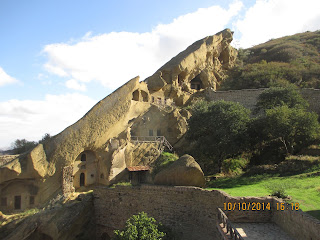Flooding in Tblisi, Georgia over the weekend, 14th June 2015
Those of you who keep up with events overseas and natural catastrophes will have heard about the flooding in Tblisi. The capitals zoo was flooded and hundreds of animals were either drowned or escaped and there were dangerous animals including lions, bears and hippopotami (the correct Latin plural for these animals) roaming the streets in central Tblisi.
I was there in October 2014 and stayed at the Hotel Istanbul which is just opposite the zoo on the other side of the river only a short walk away across the Queen Tamar bridge. The main river has cut a deep gorge through the mountainous terrain which restricts river flow when there is a lot of rain as there had been in recent weeks.
The zoo itself is located up a small tributary of the main Mtkvari River that flows through central Tblisi. When water levels rose, water backed up the tributary and flooded the zoo, drowning many of the hapless creatures. Those that escaped roamed the local area or were washed down to the central city area. I watched a lot of film coverage and was looking out for familiar sky line.
The main problem is a constriction in the valley bottom just s short distance downstream. The Metchhi church is built on top of a bluff over looking the river. There is a bridge opposite and a view back towards the church. The river rose over six metres and a lot of this area would have been under water.
The constriction in the river was also an ancient critical crossing point to control trade and movement of people. Hence the castle on top of the hill and one of my first selfies. Its a bit of a climb to get up but the architecture on route, both ecclesiastical and secular is worth it. There is also a cable car with the top station visible to the right of the castle so one way can be taken in comfort and you can appreciate the views.
Tblisi was named after the warm water that was found here that bubbled up naturally from hot springs on the southern end of the bridge up a small tributary. There are several spas still operating, the more affordable ones being on the left but the most up market one is on the right, built with so many azure tiles that it looks more like a mosque than a spa. This is located a short walk from the bridge over the river.
With such catastrophic flooding, this area would have suffered a lot of damage and I will be contributing to the disaster effort when an appeal is launched. I would urge everyone else to also contribute to the restoration of the history of the city and to restore the zoo.
To end on an up note just before arriving in Tblisi I visited the David Gareji Monastery right on the border between Gerogia and Azerbaijan to the south. It is set in a remote sensitive and mountainous border region. It is a bit of trouble to get there but worth the effort. After leaving the local town of Sagarejo the roads deteriorate and finally it is over an hour of just tracks.
The monastery was originally carved out of the rock but buildings have been added since to extend the facility.
The Azeri border is literally at the top of the hill behind the monastery and there are frequent military patrols that check passports and visas and access can be restricted at a moments notice. One such incident had happened two days before so we were grateful to get access with being stopped.
It is a beautiful location with a small chapel built on the spine of the hill. It is as undeveloped as it must have been hundreds of years ago and some of the surrounding scenery can be seen in the background. The best pieces of art are in the man made caves hollowed out of the rock just beneath the spine, unfortunately on the Azeri side so not every one gets to see them on a visit.







































